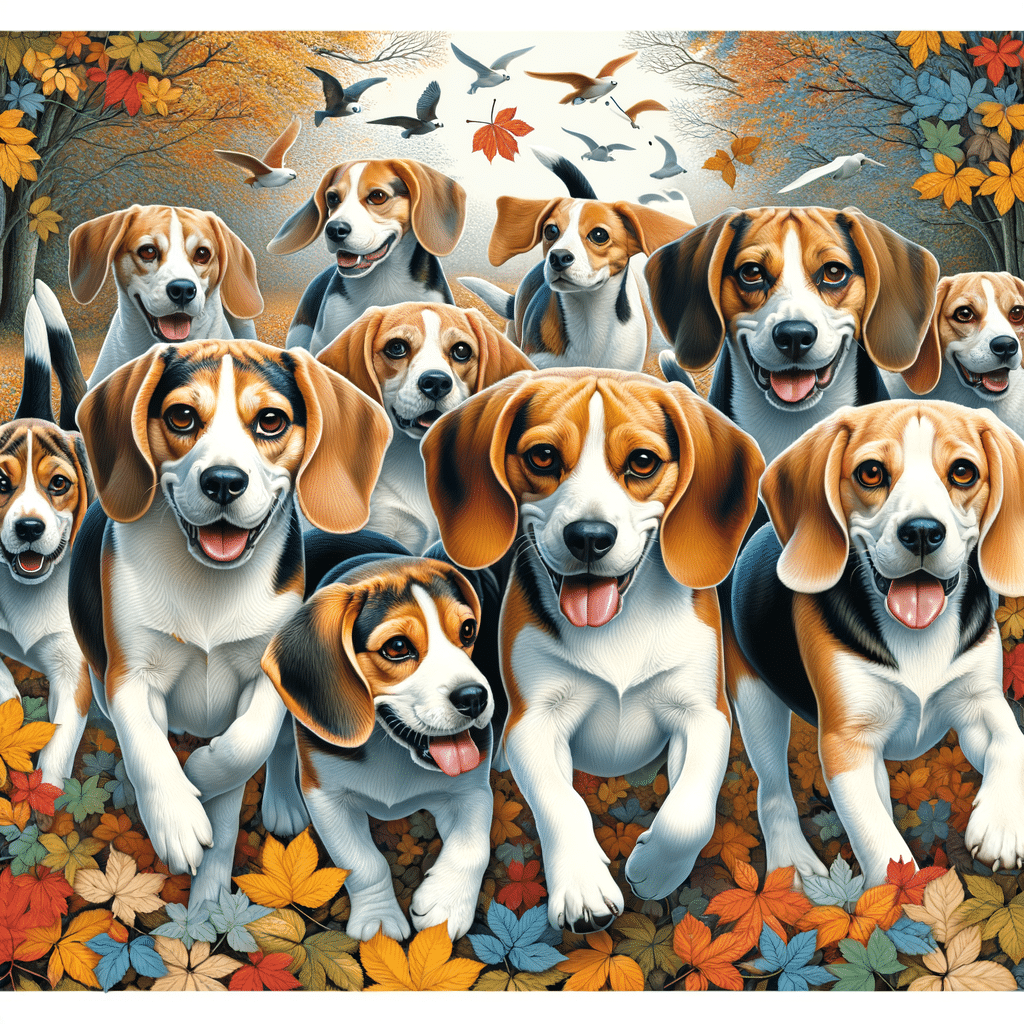Beagles are known for their energy and stamina and require sufficient daily exercise to maintain their health and happiness. The right amount of exercise for a beagle keeps them physically fit and mentally stimulated, helping prevent destructive behaviors that arise from boredom.
In This Article
- Understanding Beagle Exercise Needs
- Tailored Exercise Routines
- Practical Exercise Tips
- Incorporating Exercise into Daily Life
- Frequently Asked Questions
An adult beagle typically requires 60 to 90 minutes of exercise daily. This exercise should be a mix of physical activity, ranging from brisk walking to running, and activities that stimulate their mind. Younger beagles may have greater energy levels and require more intense sessions of activity, while senior dogs might need less exercise tailored to their mobility and health. Ensuring a beagle’s exercise needs are met is essential in preventing common health problems and can increase their life expectancy.
Highlights
- Beagles require 60-90 minutes of daily exercise to sustain physical health and mental well-being.
- Tailoring exercise routines to a beagle's age and health is vital for their overall care.
- Physical activities and mental stimulation are crucial for a healthy, well-behaved beagle.3
Understanding Beagle Exercise Needs
Beagle exercise demands vary by age, with adult beagles needing up to 90 minutes and puppies and seniors requiring modified routines.
Physiological Benefits
Beagle puppies flourish with physical activity that supports their skeletal system and overall fitness level. Maintaining a routine of shorter, more frequent outings intermixed with play promotes health and stamina.
For adult beagles, 60-90 minutes of daily activity is crucial to maintaining optimal health, and fitness levels are pivotal in warding off health problems.
Senior beagles benefit substantially from 30-60 minutes of gentle exercise distributed across the day, protecting against the decline of their physical capabilities and sustaining their well-being.
Recommended Daily Exercise:
- Puppies: Short, frequent sessions (5-10 minutes several times a day).
- Adults: 60-90 minutes, can be split into multiple sessions.
- Seniors: 30-60 minutes, preferably divided into smaller sessions
Behavioral Implications
Regular exercise for a beagle provides more than physical benefits. It also helps promote mental well-being. Adequate physical and mental exercise can prevent destructive behaviors and anxiety, often manifesting when a beagle is under-stimulated.
With their boundless energy, puppies require sufficient mental challenges to funnel their curiosity productively. Meanwhile, adult dogs need physical exercise to release pent-up energy, sustain mental acuity, and manage anxiety. In senior beagles, mental and physical exercise caters to their evolving needs, ensuring ongoing engagement and cognitive health.
Physical Exercise Includes:
- Walks
- Playtime
- Controlled running
Mental Stimulation Methods:
- Puzzle toys
- Obedience training
- Sniffing games
Tailored Exercise Routines
Creating a tailored exercise routine is crucial for beagles at every life stage to ensure their health and happiness. These routines should incorporate play, periods of rest, and various activities suited to the dog’s age and energy levels.
Puppy Playtime
Puppies tend to have bursts of energy interspersed with the need for frequent naps. A beagle puppy’s routine should focus on short, gentle play sessions that include:
- Fetch: Encourages running and provides mental stimulation.
- Basic Agility: Simple obstacle courses enhance coordination.
Activities should be limited to a few minutes, concluding with plenty of rest to prevent overexertion.
Adult Beagle Activities
An adult beagle thrives on a blend of physical and mental exercise that can include:
- Running: Maintains cardiovascular fitness and helps manage weight.
- Swimming: Offers joint-friendly exercise and helps improve endurance.
- Hiking: Engages various muscle groups and satisfies their instinctual urge to track.
- Agility Training: Sharpens their reflexes through more complex obstacle courses.
These activities keep Beagles physically fit and mentally sharp, fulfilling their sensory stimulation needs.
Senior Beagle Considerations
Senior beagles require a gentler approach to exercise, with an emphasis on:
- Short Walks: Keeps them mobile without causing undue stress on aging joints.
- Light Play: Allows them to engage at their own pace while still being active.
It is vital to incorporate rest periods and to monitor for signs of fatigue or discomfort during activities.
Practical Exercise Tips
Providing the right amount and type of exercise for beagle is crucial for their physical and mental well-being. Let’s explore ways to ensure your beagle gets their needed exercise safely.
Safety Guidelines
When exercising your beagle, safety should be the top priority. Ensuring they have received all necessary vaccinations before frequenting public spaces is vital to prevent illness. Always use a sturdy leash and harness to maintain control and prevent injuries.
Leash training is essential to help manage your beagle’s instincts to follow scents and prevent them from running into hazardous areas. Regularly check your beagle’s body for any signs of injury or discomfort after exercise.
- Leash: Always use a solid leash to maintain control.
- Vaccinations: Keep up to date with vaccinations.
- Injury Checks: Examine for signs of discomfort after physical activities.
Weather Accommodations
Beagles can be sensitive to extreme weather conditions, so exercise must be adjusted accordingly. During hot weather, avoid the peak heat hours to prevent heatstroke and ensure they have ample water. In cold temperatures, limit their time outside to prevent hypothermia, and consider a dog jacket if needed. Adapting to the current temperature and providing a comfortable environment for their physical activity helps ensure they stay healthy while benefiting from their exercise.
- Heat: Exercise in the morning or evening to avoid peak heat.
- Cold: Shorten outdoor exercise and consider a coat.
Engaging Activities
Variety in exercise helps keep your beagle engaged and prevents boredom. Mix moderate exercises such as walking with short bursts of intense exercise like frisbee or fetch to cater to their energy levels. Recalls and bite inhibition exercises are also beneficial.
Activities should be physically stimulating and mentally challenging to satisfy their hunting instincts.
Types of Exercise :
- Moderate: Daily walks, tug of war.
- Intense: Frisbee, fetch, and other high-energy games.
Incorporating Exercise into Daily Life
To maintain a beagle’s health and happiness, integrating consistent exercise into their daily routine is essential, focusing on fun and varied activities that satisfy their energetic nature.
Creating a Routine
A predictable exercise routine for beagles balances their energy levels and maintains a healthy weight. Owners should aim for 60-90 minutes of daily activity, divided into at least two sessions to prevent boredom and obesity.
Walks should be at a brisk pace and can incorporate scent work to engage the beagle’s natural hunting instincts. Proper exercise keeps beagles fit and reduces stress and potential separation anxiety.
- Morning: Begin with a 30-minute walk or jog, ensuring a brisk pace. It stimulates the dog's mind and body early in the day.
- Evening: Conclude the day with another walk or a visit to the dog park for playtime, allowing for socialization and the freedom to run around.
Interactive Play and Training
Engaging in interactive play and training adapts to a beagle’s intelligence and social needs.
- Indoor Exercise: On days when outdoor activities are limited, indoor play sessions with toys that promote movement and problem-solving are beneficial.
- Obedience Training: Obedience training sessions can mentally stimulate beagles and strengthen the bond between pet and owner.
Cardio exercises are fundamental, involving more vigorous play at the park or in a secure yard. Playtime is about physical exertion and fulfilling the beagle’s social and mental needs via games involving fetching or tug-of-war. Always consider the health status of the beagle to tailor the intensity and form of exercise, ensuring a well-rounded approach to their well-being.
Frequently Asked Questions
Understanding the exercise requirements of Beagles is crucial for their health and happiness. This section answers common queries about adequately exercising a Beagle at different stages of life and in comparison with similar breeds.
What is the recommended daily exercise duration for a beagle puppy?
A beagle puppy generally requires shorter yet more frequent exercise sessions due to their growing bodies. They should be engaged in around 20-30 minutes of exercise spread throughout the day.
Can you describe an ideal daily routine with sufficient exercise for a beagle?
An ideal routine for a beagle typically includes two walks per day, each lasting 30 to 45 minutes, combined with playtime and mental stimulation activities between walks. This provides a balance of physical exertion and mental engagement.
What types of activities are best for tiring out a beagle?
Activities like long walks, hiking, playing fetch, and participating in dog agility or scent work are excellent for tiring out a beagle. These dogs thrive with varied activities that challenge both their body and mind.
Is there a significant difference in exercise needs between beagle puppies and adults?
Beagle puppies have less stamina and require less intense but more frequent periods of exercise. This changes as they age, with adult beagles needing more extended periods of vigorous activity, usually totaling 60-90 minutes daily.
How does the exercise requirement of beagles compare to that of Basset Hounds?
Beagles generally have higher exercise requirements than Basset Hounds. While beagles need up to 90 minutes of exercise daily, Basset Hounds often require less due to their shorter legs and heavier build.
What are some common behaviors that Beagles may exhibit if they are not receiving adequate exercise?
Beagles not getting enough exercise may display excessive barking, digging, restlessness, and destructive chewing. They can become anxious or show signs of obesity when exercise is insufficient.






